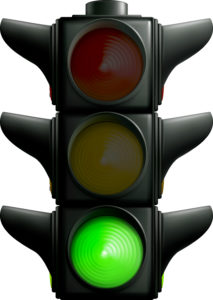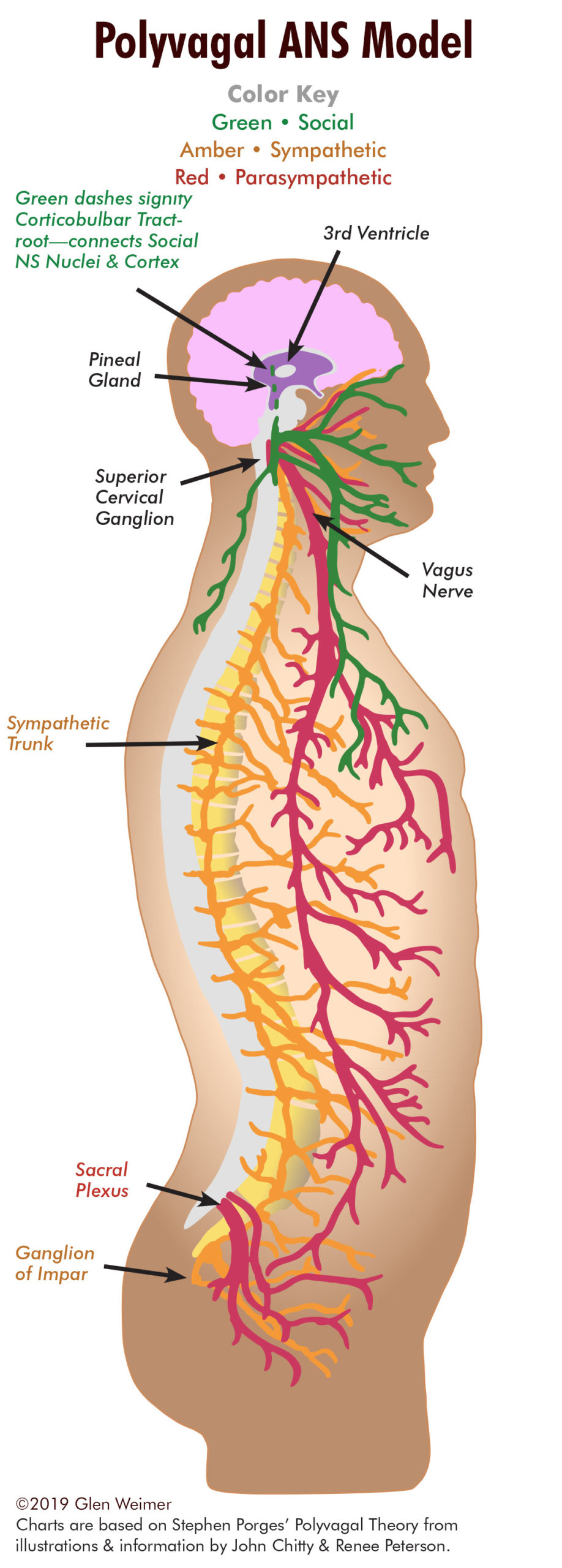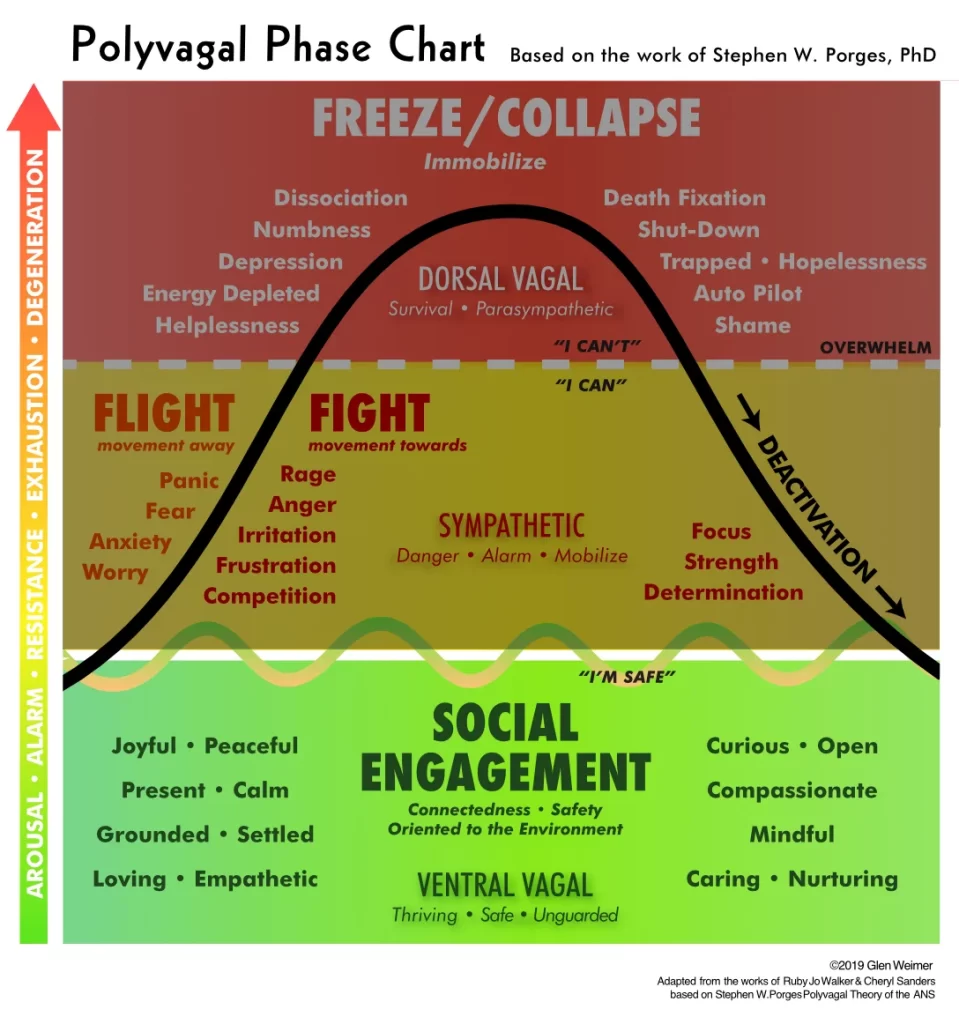Please note: this is the third of a 5-part blog. (see Parts 1 & 2)
Social Nervous System
In Part 3 we will examine the Ventral Vagal or Social Nervous System more closely: how it affects our BodyMind System (BMS), why it is critical for optimal health, and how to achieve and maintain this state.
Ventral Vagal Complex • Safety
The Ventral Vagal Complex (VVC) is all about safety, security, bonding and socializing. It establishes healthy interconnections with our world. It’s our GREEN LIGHT / Go Mode!
The quality and level to which we receive love, nurturing, touch, eye contact and bonding as an infant sets the stage for how we engage with our inner and outside world throughout life. In those very early months we recognize the world as either safe or threatening to our survival. These patterns become imprinted deep in our psyche and form a fundamental perception of life which colors how we interpret subsequent events. Each new experience is a modifier, layered on top of those initial impressions.
Safety enables us to calm our nervous system, connect with others, become curious, open, trusting, compassionate, joyful and creative. In return we can be present, grounded, empathetic and caring towards others. We can sit still and just be, secure in the knowledge we are safe in the world. In turn we can flow with life.
 Polyvagal ANS Pathways
Polyvagal ANS Pathways
The Vagus or 10th cranial nerve establishes a direct line of communication between the brain and body. It can be said to be the master switch for our Autonomic Nervous System (ANS). Dr. Stephen Porges described two distinct vagal pathways: Ventral Vagal (green) which controls facial muscles, voice, hearing, heart and lungs (generally front of the body above the diaphragm); Dorsal Vagal (red) which controls brain stem, digestion and reproduction (generally below the diaphragm governing core survival functions). The third pathway is the Sympathetic Nervous System (SNS – orange) which comes off of a trunk or chain of nerves running alongside the spine at the level of the chest and low back (controlling mobilization of the torso, arms and legs to fight and flee). Each system up-regulates certain body functions and down-regulates opposing ones.
Facial & Vocal Expressiveness
Our Neuroception scans faces specifically for signs of safety. We need to know if the eyes and face are conveying the same message of safety, or hiding some level of deceit. Our systems tend to err on the side of danger, as its whole purpose is to ensure our survival.
In Ventral Vagal (VVC) our ears are attuned to the mid-frequency range, that of the human voice. Vocal prosody, that high singsong voice puts us at ease which is why we automatically adopt it when speaking to children and animals. We listen for this vocal expressiveness in others, and use it to assure others we pose no threat.
Breath & Pulse
In VVC our breath and heart rate are slow and measured. We feel calm and relaxed. Long extended out breaths enable the tissues of the body to soften and relax. Chanting, toning or playing wind instruments capitalize on this protracted exhale and add the benefit of tonal frequencies that stimulate different aspects of the full co-regulated ANS simultaneously. Community choirs provide the extra benefit to our social engagement system by reinforcing this with safe interactions.
Yoga and other stretching practices enlist the power of the exhale to relax our muscles and settle our nervous system. It is also often occurs in safe, healing, social environments.
 Sucking, swallowing and breathing all use the same mechanism and psychological associations of nurturing and supporting life. Insecurities in infancy form the basis of many eating disorders where we attempt to calm an overactive nervous system with emotional eating.
Sucking, swallowing and breathing all use the same mechanism and psychological associations of nurturing and supporting life. Insecurities in infancy form the basis of many eating disorders where we attempt to calm an overactive nervous system with emotional eating.
For me this shows up as nonstop noshing on long road trips. Reflecting on it, I recognize that driving in highway traffic makes me anxious. Even though I don’t consciously feel overly concerned, this oral self-soothing tells me what is really going on with my BMS. Only after our nervous system instinctually reacts to external stimuli does our conscious mind attempt to concoct a narrative to make sense of our actions and emotions. Our initial response is unconscious, but with practice we can begin to recognize these 3 autonomic states within ourselves and take back control of our reactions. (see parts 4 & 5).
Digestion
Although it’s mainly associated with our head, throat and chest, when our VVC/Social Nervous System is working in concert with our Dorsal Vagal /PNS our body systems function optimally. In particular, the digestive system is primed to function at its best. The mouth secretes saliva to begin breaking down food; the stomach produces acid; and the liver and pancreas release enzymes into the small intestine to complete the digestive process. Increased intestinal motility moves this along, assimilates the nutrients and eliminates waste.
Additionally, VVC increases our blood flow to ‘non-essential’ organs like the skin and improves our body’s immune response.
 Brain
Brain
This Social NS sends blood flow to the outer regions of the cerebral cortex to allow us to think clearly, problem solve, express our emotions, remember, and create. Conversely, the other two nervous systems impair higher cognitive functions focusing our energy on survival and instinctual protective responses.
Social Bonds
Dr. Porges, termed this the Ventral Vagal Complex (VVC) our Social Nervous System because only through our experience of safety can we connect to our world. Safety is CRITICAL! Safety allows us to get close to others; proximity enables us to interact; that connection enables bonding; and this nexus empowers us to THRIVE!
Social engagement enables us to co-regulate our nervous system. We crave belonging and acceptance as part of this biological imperative to connect. Through our interconnections we draw the strength to meet life’s many challenges. We give and receive messages of acceptance through eye contact, words and physical touch. A welcoming embrace immediately settles our nervous system.
Getting There & Living There
Every single one of us has multiple traumas in our past which makes it, at times, difficult to settle our nervous systems and return to our VVC connectedness. Admittedly, some of us have a harder time of it than others. If you are still reading this blog, chances are that’s true for you. The power of this model is that, through understanding what these autonomic states look like in our lives and in ourselves, we can begin to take back control and make changes that will dramatically impact our experience of life, how others respond to us, and the health of our bodies.
To paraphrase author, Deb Dana, it’s an unreasonable, and unattainable expectation to remain always in VVC. The important thing is our ability to recognize when we move into a place of protection and to navigate back into connection and safety, that’s the hallmark of resilience and health.
Exercises To Strengthen Vagal Tone
Here are some key components that can help us get there and live there.
- Feeling Safe is the foundation! Develop environments that feel safe to work, play, learn and live in. Cultivate safety in every aspect of life.
- Breathe! Slow, rhythmic, diaphragmatic breathing. Breathing from your diaphragm, rather than shallowly from the top of the lungs stimulates and tones the VVC.
- Hum / Tone! Since the vagus nerve is connected to the vocal cords, humming mechanically stimulates it. You can hum a song, or even better tone the sound ‘OM’.
- Speak with smiles, eye contact, and in a prosodic (singsongy) voice.
- Listen to Mid-frequency Music—prosodic (Disney-like soundtracks) or calming meditative music.
- Slow Down! Whenever possible slow life down, take a breath, take a time-out moment to collect your thoughts and assess your feelings. Baby-steps enable us to better self-sooth and self-regulate.
- Wash Your Face with cold water! The mechanism isn’t fully known, but cold water on your face is calming.
- Meditate! Loving kindness meditation promotes feelings of goodwill towards yourself and others.
- Balance Your Gut Microbiome! The presence of healthy bacteria in the gut creates a positive feedback loop through the vagus nerve, increasing its tone.
- Play! Create opportunities for fun. Start by taking yourself on solo play-dates, then engage one or two friends in having fun.
- Socialize! This may be the hardest step. The more trauma we have, the more we have been hurt in our interactions with others and prefer to isolate. Take baby-steps. Slowly build your circle of safe people to engage and interact. Then build safe groups to interact with: a religious or spiritual community, healthy movement studio or gym, music group (choir, drum circle), support group (12-step), meditation or personal development, etc.
Continue reading. Go to Polyvagal Theory – Part 4
NOTE: The Social Nervous System is the Ventral Vagal (VVC) branch of the Parasympathetic Nervous System. Up until now I have avoided referring to it as part of the PNS to minimize initial confusion between the two branches.
Polyvagal Theory Resources:
- Dana, Deb A., Anchored: How to Befriend Your Nervous System Using Polyvagal Theory (2022)
- Dana, Deb A., The Polyvagal Theory in Therapy: Engaging the Rhythm of Regulation (2018)
- Porges, Stephen W., The Pocket Guide to the Polyvagal Theory: The Transformative Power of Feeling Safe (2017)
- Rosenberg, Stanley, Accessing the Healing Power of the Vagus Nerve: Self-help Exercises for Anxiety, Depression, Trauma and Autism (2017)
- Also go to blogs Resourcing: Meeting Life’s Challenges
- Overwhelm: The Root Cause of All Disease – Parts 1 to 4
- Trauma & Bodywork Thesis
- Body-Mind-Spirit 1: Consciousness
Disclaimer:
The information featured on this site is provided for information and education purposes only and is not intended to replace the advice of your doctor or health care provider on medical and/or health-related issues.
You should not use the information on this site for diagnosis or treatment of any health problem or as a substitute for medication or other treatment prescribed by your physician or health care provider.
Submit your review | |


